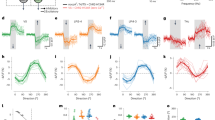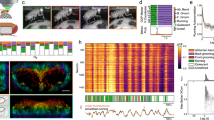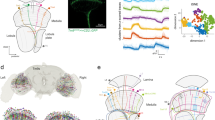Abstract
Typically, neurons in sensory areas are highly interconnected. Coupling two neurons can synchronize their activity and affect a variety of single-cell properties, such as their stimulus tuning, firing rate or gain. All of these factors must be considered to understand how two neurons should be coupled to optimally process stimuli. We quantified the functional effect of an interaction between two optic-flow processing neurons (Vi and H1) in the fly (Lucilia sericata). Using a generative model, we estimated a uni-directional coupling from H1 to Vi. Especially at a low signal-to-noise ratio (SNR), the coupling strongly improved the information about optic-flow in Vi. We identified two constraints confining the strength of the interaction. First, for weak couplings, Vi benefited from inputs by H1 without a concomitant shift of its stimulus tuning. Second, at both low and high SNR, the coupling strength lay in a range in which the information carried by single spikes is optimal.
This is a preview of subscription content, access via your institution
Access options
Subscribe to this journal
Receive 12 print issues and online access
$209.00 per year
only $17.42 per issue
Buy this article
- Purchase on Springer Link
- Instant access to full article PDF
Prices may be subject to local taxes which are calculated during checkout







Similar content being viewed by others
References
Gilbert, C.D. & Wiesel, T.N. Intrinsic connectivity and receptive field properties in visual cortex. Vision Res. 25, 365–374 (1985).
DeVries, S.H. & Baylor, D.A. Synaptic circuitry of the retina and olfactory bulb. Cell 72 (suppl.) 139–149 (1993).
Nassi, J.J. & Callaway, E.M. Parallel processing strategies of the primate visual system. Nat. Rev. Neurosci. 10, 360–372 (2009).
Borst, A., Haag, J. & Reiff, D.F. Fly motion vision. Annu. Rev. Neurosci. 33, 49–70 (2010).
Read, H.L., Winer, J.A. & Schreiner, C.E. Functional architecture of auditory cortex. Curr. Opin. Neurobiol. 12, 433–440 (2002).
Averbeck, B.B., Latham, P.E. & Pouget, A. Neural correlations, population coding and computation. Nat. Rev. Neurosci. 7, 358–366 (2006).
Usrey, W.M. & Reid, R.C. Synchronous activity in the visual system. Annu. Rev. Physiol. 61, 435–456 (1999).
Tkacik, G., Prentice, J.S., Balasubramanian, V. & Schneidman, E. Optimal population coding by noisy spiking neurons. Proc. Natl. Acad. Sci. USA 107, 14419–14424 (2010).
Farrow, K., Borst, A. & Haag, J. Sharing receptive fields with your neighbors: tuning the vertical system cells to wide field motion. J. Neurosci. 25, 3985–3993 (2005).
Olsen, S.R., Bhandawat, V. & Wilson, R.I. Excitatory interactions between olfactory processing channels in the Drosophila antennal lobe. Neuron 54, 89–103 (2007).
Olsen, S.R. & Wilson, R.I. Lateral presynaptic inhibition mediates gain control in an olfactory circuit. Nature 452, 956–960 (2008).
Cafaro, J. & Rieke, F. Noise correlations improve response fidelity and stimulus encoding. Nature 468, 964–967 (2010).
Hausen, K. The lobula-complex of the fly: structure, function and significance in visual behavior. in Photoreception and Vision in Invertebrates (ed. M.A. Ali) 523–559 (Plenum Press, New York, 1984).
Krapp, H.G. & Hengstenberg, R. Estimation of self-motion by optic flow processing in single visual interneurons. Nature 384, 463–466 (1996).
Borst, A. & Weber, F. Neural action fields for optic flow based navigation: a simulation study of the fly lobula plate network. PLoS ONE 6, e16303 (2011).
Haag, J. & Borst, A. Neural mechanism underlying complex receptive field properties of motion-sensitive interneurons. Nat. Neurosci. 7, 628–634 (2004).
Pillow, J.W. et al. Spatio-temporal correlations and visual signaling in a complete neuronal population. Nature 454, 995–999 (2008).
Okatan, M., Wilson, M.A. & Brown, E.N. Analyzing functional connectivity using a network likelihood model of ensemble neural spiking activity. Neural Comput. 17, 1927–1961 (2005).
Paninski, L., Pillow, J. & Lewi, J. Statistical models for neural encoding, decoding, and optimal stimulus design. Prog. Brain Res. 165, 493–507 (2007).
Beersma, D.G.M., Stavenga, D.G. & Kuiper, J.W. Retinal lattice, visual field and binocularities in flies. J. Comp. Physiol. [A] 119, 207–220 (1977).
Haag, J. & Borst, A. Reciprocal inhibitory connections within a neural network for rotational optic-flow processing. Front. Neurosci. 1, 111–121 (2007).
Haag, J. & Borst, A. Dendro-dendritic interactions between motion-sensitive large-field neurons in the fly. J. Neurosci. 22, 3227–3233 (2002).
Haag, J. & Borst, A. Orientation tuning of motion-sensitive neurons shaped by vertical-horizontal network interactions. J. Comp. Physiol. [A] 189, 363–370 (2003).
Borst, A. & Theunissen, F.E. Information theory and neural coding. Nat. Neurosci. 2, 947–957 (1999).
Reichardt, W. Autocorrelation, a principle for the evaluation of sensory information by the central nervous system. in Principles of Sensory Communication (ed. W.A. Rosenblith) 303–317 (MIT Press and John Wiley & Sons, 1961).
Haag, J., Denk, W. & Borst, A. Fly motion vision is based on Reichardt detectors regardless of the signal-to-noise ratio. Proc. Natl. Acad. Sci. USA 101, 16333–16338 (2004).
Gerwinn, S., Macke, J.H. & Bethge, M. Bayesian inference for generalized linear models for spiking neurons. Front. Comput. Neurosci. 4, 12 (2010).
Weber, F., Machens, C.K. & Borst, A. Spatiotemporal response properties of optic-flow processing neurons. Neuron 67, 629–642 (2010).
Rieke, F., Bialek, W. & Warland, D. Spikes (Mit Press, 1999).
Machens, C.K. et al. Representation of acoustic communication signals by insect auditory receptor neurons. J. Neurosci. 21, 3215–3227 (2001).
Bialek, W., Rieke, F., de Ruyter van Steveninck, R. & Warland, D. Reading a neural code. Science 252, 1854–1857 (1991).
Bair, W., Zohary, E. & Newsome, W.T. Correlated firing in macaque visual area MT: time scales and relationship to behavior. J. Neurosci. 21, 1676–1697 (2001).
Zohary, E., Shadlen, M.N. & Newsome, W.T. Correlated neuronal discharge rate and its implications for psychophysical performance. Nature 370, 140–143 (1994).
Moore, G.P., Segundo, J.P., Perkel, D.H. & Levitan, H. Statistical signs of synaptic interaction in neurons. Biophys. J. 10, 876–900 (1970).
Kohn, A. & Smith, M.A. Stimulus dependence of neuronal correlation in primary visual cortex of the macaque. J. Neurosci. 25, 3661–3673 (2005).
Smith, M.A. & Kohn, A. Spatial and temporal scales of neuronal correlation in primary visual cortex. J. Neurosci. 28, 12591–12603 (2008).
Takeuchi, D., Hirabayashi, T., Tamura, K. & Miyashita, Y. Reversal of interlaminar signal between sensory and memory processing in monkey temporal cortex. Science 331, 1443–1447 (2011).
Brody, C.D. Correlations without synchrony. Neural Comput. 11, 1537–1551 (1999).
Cohen, M.R. & Kohn, A. Measuring and interpreting neuronal correlations. Nat. Neurosci. 14, 811–819 (2011).
de la Rocha, J., Doiron, B., Shea-Brown, E., Josic, K. & Reyes, A. Correlation between neural spike trains increases with firing rate. Nature 448, 802–806 (2007).
Cohen, M.R. & Maunsell, J.H.R. Attention improves performance primarily by reducing interneuronal correlations. Nat. Neurosci. 12, 1594–1600 (2009).
Schneidman, E., Berry, M.J., Segev, R. & Bialek, W. Weak pairwise correlations imply strongly correlated network states in a neural population. Nature 440, 1007–1012 (2006).
Shlens, J. et al. The structure of multi-neuron firing patterns in primate retina. J. Neurosci. 26, 8254–8266 (2006).
Stevenson, I.H. & Kording, K.P. How advances in neural recording affect data analysis. Nat. Neurosci. 14, 139–142 (2011).
Nauhaus, I., Busse, L., Carandini, M. & Ringach, D.L. Stimulus contrast modulates functional connectivity in visual cortex. Nat. Neurosci. 12, 70–76 (2009).
Schilstra, C. & Hateren, J.H. Blowfly flight and optic flow. I. Thorax kinematics and flight dynamics. J. Exp. Biol. 202, 1481–1490 (1999).
Ko, H. et al. Functional specificity of local synaptic connections in neocortical networks. Nature 473, 87–91 (2011).
Elyada, Y.M., Haag, J. & Borst, A. Different receptive fields in axons and dendrites underlie robust coding in motion-sensitive neurons. Nat. Neurosci. 12, 327–332 (2009).
Acknowledgements
We thank E. Schneidman and G. Tkacik for important discussions during the Methods in Computational Neuroscience course in Woods Hole, Massachusetts. We thank M. Walter for improving the functionality of the LED arena, F. Schwarz for help with the experiments and H. Eichner for critically reading the manuscript. F.W. is supported by a grant from the Deutsche Forschungsgemeinschaft (DFG, Research Training Group 1091) and the Max Planck Society. C.K.M. is funded through the Emmy-Noether program of the DFG and a “Chaire d'excellence” of the Agence National de la Recherche.
Author information
Authors and Affiliations
Contributions
F.W., C.K.M. and A.B. designed the study. F.W. performed all of the experiments and analyzed the data. F.W., C.K.M. and A.B. wrote the manuscript.
Corresponding author
Ethics declarations
Competing interests
The authors declare no competing financial interests.
Supplementary information
Supplementary Text and Figures
Supplementary Figures 1–7 and Supplementary Results (PDF 466 kb)
Rights and permissions
About this article
Cite this article
Weber, F., Machens, C. & Borst, A. Disentangling the functional consequences of the connectivity between optic-flow processing neurons. Nat Neurosci 15, 441–448 (2012). https://doi.org/10.1038/nn.3044
Received:
Accepted:
Published:
Issue Date:
DOI: https://doi.org/10.1038/nn.3044



